Richards Packaging Bundle
Can Richards Packaging Company Continue Its Packaging Industry Dominance?
Richards Packaging Company, a key player in the North American packaging industry, is making strategic moves. Recent acquisitions, including HL Production SA and National Dental Inc. in February 2025, highlight its ambitious Richards Packaging SWOT Analysis and commitment to growth, especially in the lucrative healthcare sector. Founded in 1912, the company has evolved significantly, offering comprehensive packaging solutions and services.
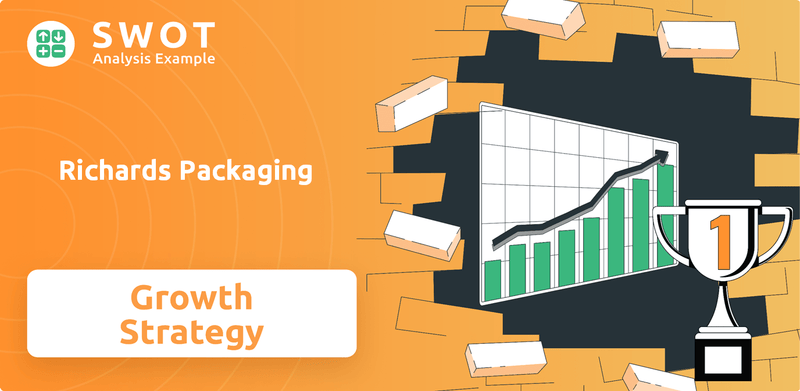
This analysis dives deep into Richards Packaging Company's Growth Strategy, examining its Future Prospects and the driving forces behind its expansion. We'll explore the company's market share, financial performance, and potential investment opportunities, providing insights for informed decision-making in the dynamic packaging landscape. Understanding the competitive landscape and the impact of e-commerce on packaging solutions is crucial for assessing Richards Packaging Company's long-term success and expansion plans.
How Is Richards Packaging Expanding Its Reach?
The growth strategy of Richards Packaging Company centers on strategic acquisitions and organic expansion to boost its market presence and diversify its product offerings within the packaging industry. This approach aims to strengthen its position and capitalize on emerging opportunities. The company's expansion plans are designed to enhance its capabilities and reach across various sectors.
A key element of Richards Packaging Company's strategy involves 'tuck-in acquisitions,' integrating smaller businesses to enhance its existing operations. This method allows for the rapid incorporation of new technologies, markets, and customer bases. These acquisitions are expected to be accretive to earnings, contributing to the company's financial performance.
Beyond acquisitions, Richards Packaging Company is focused on organic growth, supported by new pricing strategies and the upcoming launch of an e-commerce channel. These initiatives are designed to drive revenue growth and improve market share. The company's strong logistical capabilities and diversified end-market exposure further support its expansion efforts.
Richards Packaging Company uses acquisitions to expand its business. These acquisitions include HL Production SA and National Dental Inc. in February 2025. These acquisitions are expected to boost earnings in 2025 and expand the healthcare vertical, which accounts for over 52% of its product mix.
The company anticipates organic revenue growth of 2%–5% in 2025, barring a recession. This growth is supported by new pricing strategies and an upcoming e-commerce channel launch. Food and beverage packaging revenues grew 5% in Q1 2025, and cosmetic packaging revenues grew 3% in Q1 2025 compared to Q1 2024.
The company's expansion efforts are supported by its strong logistical capabilities across North America and diversified end-market exposure. This diversification helps to mitigate sector-specific risks and supports its overall growth strategy. The company is also focused on understanding the competitive landscape.
The acquisitions are expected to boost earnings in 2025. Management expects organic revenue growth between 2%–5% in 2025. The company's focus on healthcare, food and beverage, and cosmetic packaging sectors contributes to its financial outlook. The company's diversified end-market exposure helps mitigate risks.
Richards Packaging Company's expansion initiatives involve acquisitions and organic growth. The company is focusing on integrating new businesses and expanding its market reach. These efforts are designed to improve financial performance and strengthen its market position within the packaging industry.
- Acquisition of HL Production SA and National Dental Inc.
- Anticipated organic revenue growth of 2%–5% in 2025.
- Focus on food and beverage, cosmetic, and healthcare sectors.
- Launch of an e-commerce channel to boost sales.
Richards Packaging SWOT Analysis
- Complete SWOT Breakdown
- Fully Customizable
- Editable in Excel & Word
- Professional Formatting
- Investor-Ready Format
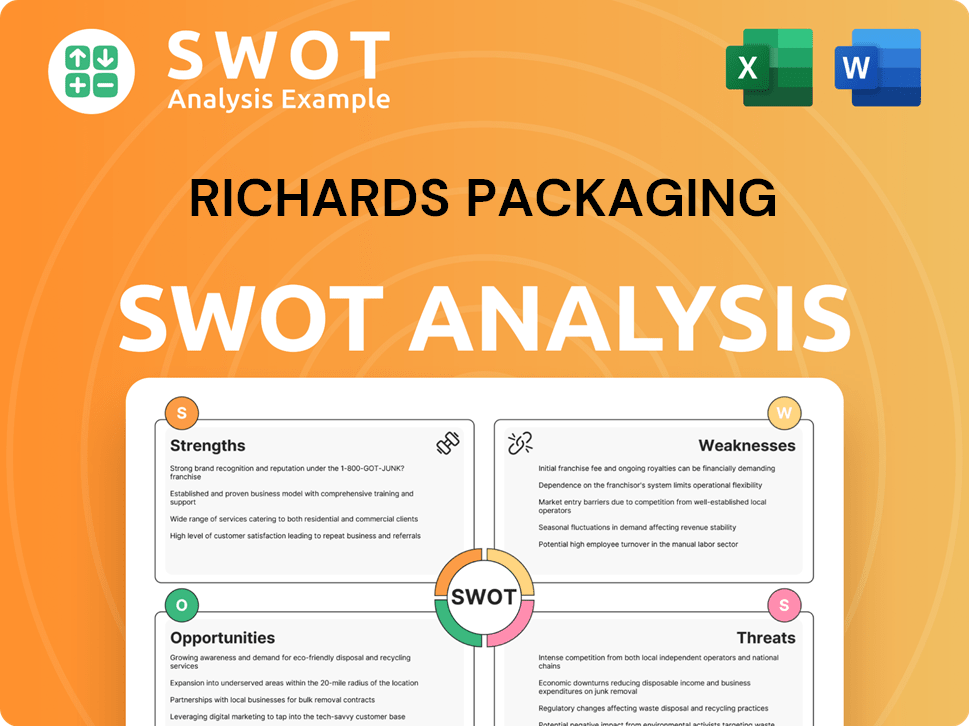
How Does Richards Packaging Invest in Innovation?
The innovation and technology strategy of Richards Packaging Company is designed to foster sustained growth within the packaging industry. The company focuses on leveraging its in-house capabilities while adapting to the evolving needs of the market. This approach is demonstrated through its product development efforts and exploration of sustainable packaging solutions.
One of the key strengths of Richards Packaging Company is its in-house plastics manufacturing capability, a distinction among North American packaging distributors. This allows for the creation of tailored packaging solutions, providing a competitive edge. The company is also focused on the ongoing 'packaging business transformation' to improve efficiency and product offerings.
The company's strategic acquisitions, such as HL Production SA, highlight an innovative approach to expanding its healthcare product portfolio. This includes leveraging established brands for international growth. Furthermore, the launch of an e-commerce channel in 2025 indicates a move towards digital transformation to reach new customers and enhance its distribution capabilities.
Richards Packaging Company's in-house plastics manufacturing is a key differentiator. This capability allows for the creation of custom packaging solutions. This vertical integration enhances control over quality and the ability to meet specific customer needs.
The company is exploring sustainable packaging options to meet the growing demand for eco-friendly solutions. This aligns with current market trends and consumer preferences. This focus can enhance the company's brand image and attract environmentally conscious customers.
The launch of an e-commerce channel in 2025 is a significant step towards digital transformation. This will expand the company's reach and improve distribution capabilities. E-commerce also provides data-driven insights for better customer engagement.
Acquisitions, such as HL Production SA, demonstrate a proactive approach to expanding the product portfolio. These strategic moves can accelerate growth and provide access to new markets. This also includes leveraging established brands for international expansion.
The 'packaging business transformation' initiative focuses on optimizing internal processes. This includes streamlining operations and potentially integrating new technologies. The goal is to improve efficiency and enhance product offerings.
Continuous product development is a core element of the company's strategy. This involves creating new packaging solutions to meet evolving customer needs. This also includes adapting to changing market demands.
Richards Packaging Company's growth strategy centers on innovation and technological advancements. This involves a combination of in-house manufacturing, strategic acquisitions, and digital transformation. The company's focus on sustainable packaging initiatives is also a key aspect of its strategy.
- In-House Manufacturing: Provides a competitive advantage through customized packaging solutions.
- Strategic Acquisitions: Expand product offerings and market reach.
- E-commerce Launch: Enhances distribution capabilities and expands customer reach.
- Sustainable Packaging: Addresses the growing demand for eco-friendly solutions.
- Process Optimization: Improves efficiency and product offerings through the 'packaging business transformation'.
Richards Packaging PESTLE Analysis
- Covers All 6 PESTLE Categories
- No Research Needed – Save Hours of Work
- Built by Experts, Trusted by Consultants
- Instant Download, Ready to Use
- 100% Editable, Fully Customizable
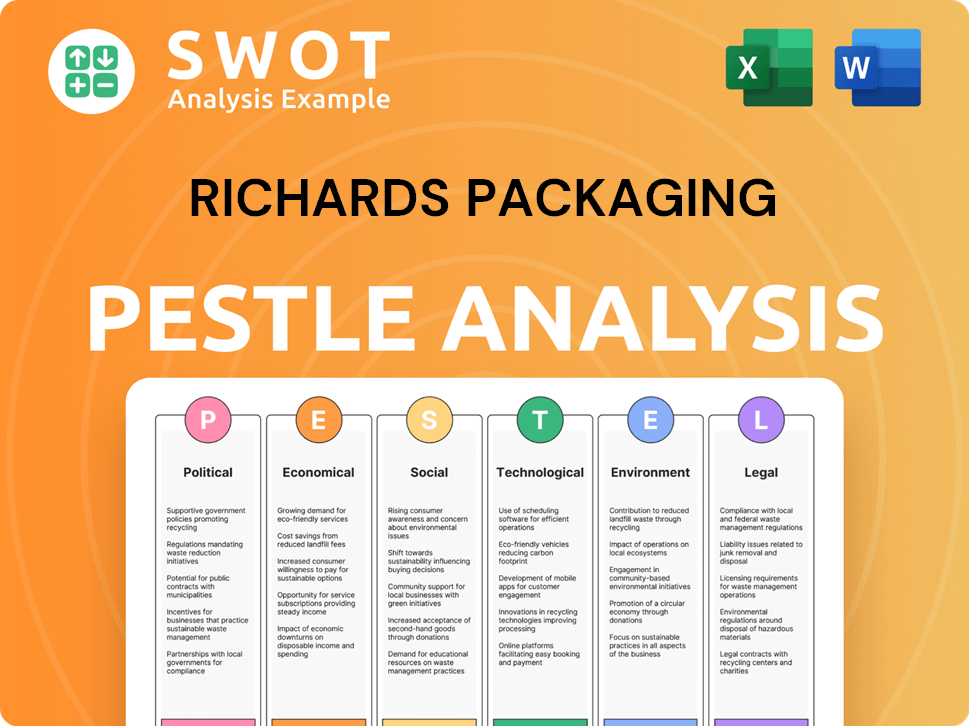
What Is Richards Packaging’s Growth Forecast?
The financial outlook for Richards Packaging Company in 2025 anticipates a return to overall revenue growth, driven by strategic acquisitions and organic initiatives. The company's growth strategy includes a focus on expanding its market presence and enhancing its product offerings within the packaging industry. This strategy is supported by recent acquisitions and a commitment to innovation.
Total revenue for the year ended December 31, 2024, was $408 million, a decrease from $426 million in 2023. This decline was primarily due to an oversupply of inventory in food and beverage and a decrease in healthcare capital equipment demand. However, the first quarter of 2025 showed a positive shift, with total revenue increasing by $2.8 million compared to the previous year. This positive trend is a key indicator of the company's future prospects.
Management is focused on achieving 2%–5% organic revenue growth in 2025, assuming no recession. This growth is expected to be supported by the integration of recent acquisitions and the continued demand for its packaging solutions. For a deeper understanding of the company's origins, you can read a Brief History of Richards Packaging.
Total revenue for 2024 was $408 million, down from $426 million in 2023. The first quarter of 2025 showed an increase of $2.8 million in total revenue compared to the previous year. The company aims for 2%–5% organic revenue growth in 2025.
Net income for 2024 decreased by $3 million. In Q1 2025, net income decreased by $3.6 million. Acquisitions are expected to boost earnings in 2025.
The company maintained a strong free cash flow of $7.3 million in 2024 and paid off all remaining debt. As of March 31, 2025, the leverage ratio was 0.3x.
The current annualized dividend rate is C$1.32 per share, with a 4.8% yield as of May 25, 2025. The payout ratio was 59% in 2024 and 39% in Q1 2025.
The financial performance of Richards Packaging Company reflects a strategic focus on sustainable growth and shareholder value. The company's ability to maintain a strong financial position while navigating market challenges highlights its resilience and strategic foresight. The following points summarize the key financial highlights:
- Revenue Growth: Anticipated return to revenue growth in 2025 driven by acquisitions and organic initiatives.
- Net Income: Net income decreased in 2024 and Q1 2025 due to specific factors, but the company is focused on improvement.
- Cash Flow and Debt: Maintained strong free cash flow and paid off all debt, with a leverage ratio of 0.3x as of March 31, 2025.
- Dividends: Consistent monthly distributions with a current annualized rate of C$1.32 per share, supported by a healthy payout ratio.
- Strategic Acquisitions: Acquisitions in early 2025 expected to be accretive to earnings, supporting financial goals.
Richards Packaging Business Model Canvas
- Complete 9-Block Business Model Canvas
- Effortlessly Communicate Your Business Strategy
- Investor-Ready BMC Format
- 100% Editable and Customizable
- Clear and Structured Layout
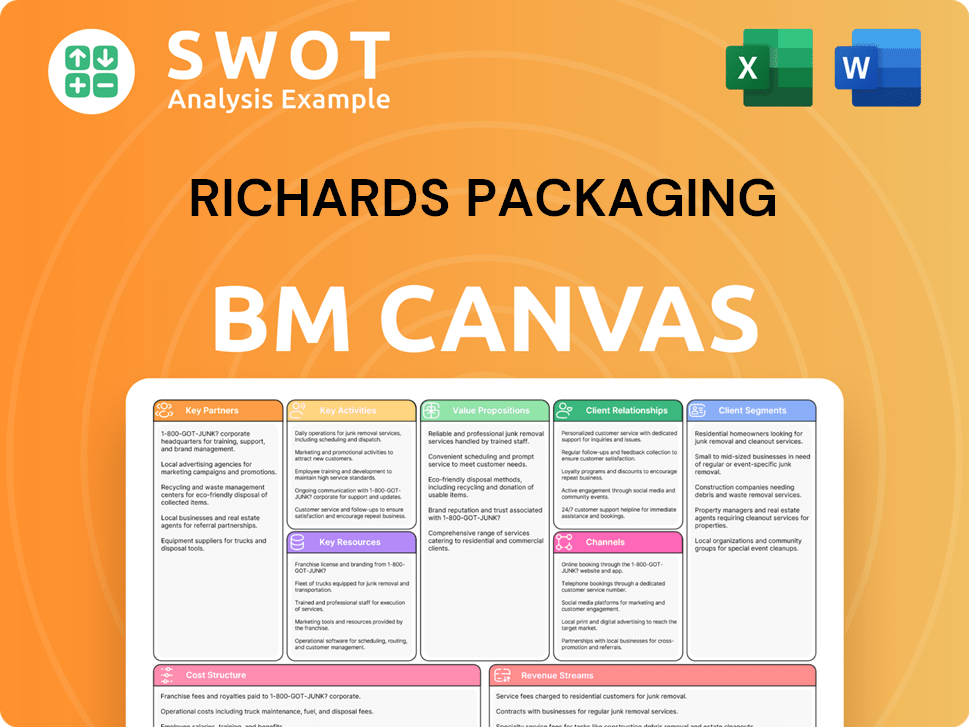
What Risks Could Slow Richards Packaging’s Growth?
The Marketing Strategy of Richards Packaging faces several potential risks and obstacles. These challenges can significantly impact its growth strategy and overall business development. Understanding these risks is crucial for investors and stakeholders looking at the future prospects of the company within the packaging industry.
Market competition remains a constant pressure, requiring continuous innovation and strategic adjustments. Regulatory changes, especially those related to environmental standards, could necessitate considerable changes to product offerings and operational practices. Supply chain disruptions and technological advancements also pose ongoing challenges that need careful management.
The company's growth strategy is also exposed to fluctuations in interest rates, impacting financial performance. The approach of acquisitions carries inherent risks, including integration challenges and financial uncertainties. Management addresses these risks through careful inventory management, diversification of end-market exposure, and a focus on maintaining strong free cash flow to mitigate potential economic uncertainties.
Intense competition in the packaging distribution sector demands continuous efforts to maintain and grow market share. Competitors constantly introduce new products and strategies, requiring the company to stay ahead through innovation and customer service. In 2024, the packaging industry saw a revenue of approximately $1.1 trillion globally, highlighting the competitive landscape.
Evolving environmental and sustainability standards for packaging can lead to significant operational adjustments. Compliance with new regulations may involve investments in eco-friendly materials and processes. The focus on sustainable packaging initiatives is growing, with an estimated 15% annual growth rate in this segment.
Disruptions in the supply chain, such as oversupply in certain sectors, can directly affect revenue and profitability. Reliance on a wide range of suppliers introduces risks related to disruptions or changes in supplier relationships. In 2024, supply chain issues impacted roughly 30% of businesses globally.
Rapid advancements in packaging materials, manufacturing processes, and digital platforms can disrupt the market. Keeping pace with these innovations is essential to avoid obsolescence and maintain a competitive edge. The packaging industry is experiencing a 8% annual growth in adopting new technologies.
Limitations in human capital and operational capacity can hinder the effective integration of acquisitions and the execution of growth strategies. Adequate resources are crucial for managing expansion plans and maintaining operational efficiency. The successful integration of acquisitions is critical, with approximately 50% of mergers failing due to integration challenges.
Exposure to fluctuations in interest rates, due to a floating interest rate credit facility, can impact financial performance. Rising interest rates can increase borrowing costs and affect profitability. Interest rate volatility has been a concern, with the Federal Reserve increasing rates several times in 2023 and early 2024.
Acquisitions carry inherent risks, including integration challenges and financial risks associated with contingent considerations. Successfully integrating acquired businesses is crucial for realizing the intended benefits of the acquisition. Approximately 20% of acquisitions fail due to integration difficulties.
The company employs strategies like careful inventory management, diversification of end-market exposure, and a focus on maintaining strong free cash flow to mitigate risks. Effective inventory management helps minimize obsolescence and reduce financial losses. Diversifying end-market exposure helps to reduce dependence on any single sector, thus improving overall financial stability.
Richards Packaging Porter's Five Forces Analysis
- Covers All 5 Competitive Forces in Detail
- Structured for Consultants, Students, and Founders
- 100% Editable in Microsoft Word & Excel
- Instant Digital Download – Use Immediately
- Compatible with Mac & PC – Fully Unlocked
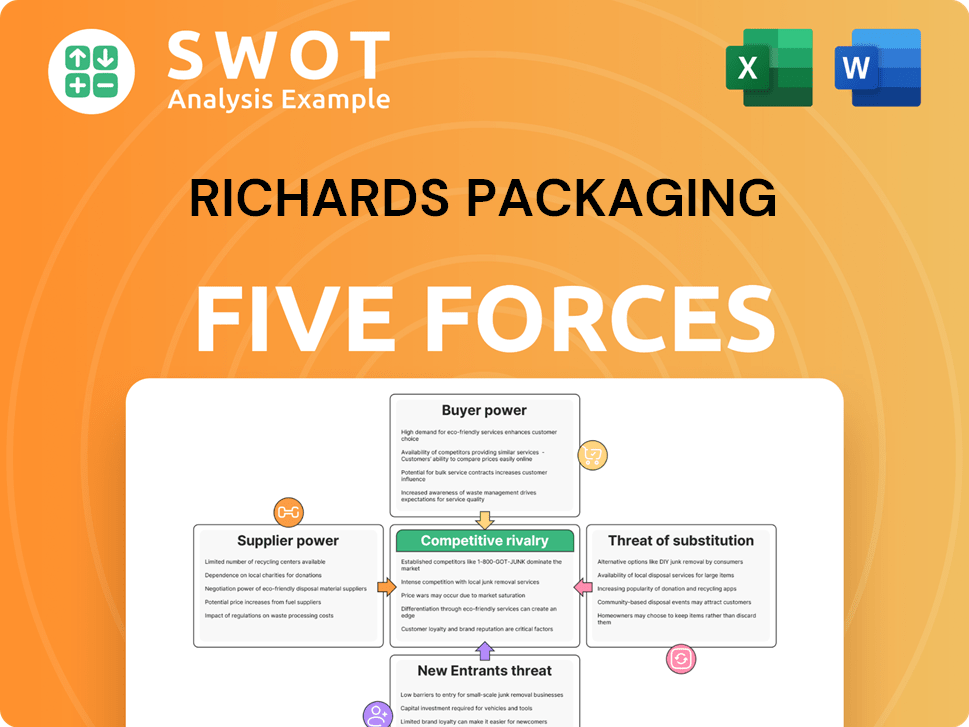
Related Blogs
- What are Mission Vision & Core Values of Richards Packaging Company?
- What is Competitive Landscape of Richards Packaging Company?
- How Does Richards Packaging Company Work?
- What is Sales and Marketing Strategy of Richards Packaging Company?
- What is Brief History of Richards Packaging Company?
- Who Owns Richards Packaging Company?
- What is Customer Demographics and Target Market of Richards Packaging Company?
Disclaimer
All information, articles, and product details provided on this website are for general informational and educational purposes only. We do not claim any ownership over, nor do we intend to infringe upon, any trademarks, copyrights, logos, brand names, or other intellectual property mentioned or depicted on this site. Such intellectual property remains the property of its respective owners, and any references here are made solely for identification or informational purposes, without implying any affiliation, endorsement, or partnership.
We make no representations or warranties, express or implied, regarding the accuracy, completeness, or suitability of any content or products presented. Nothing on this website should be construed as legal, tax, investment, financial, medical, or other professional advice. In addition, no part of this site—including articles or product references—constitutes a solicitation, recommendation, endorsement, advertisement, or offer to buy or sell any securities, franchises, or other financial instruments, particularly in jurisdictions where such activity would be unlawful.
All content is of a general nature and may not address the specific circumstances of any individual or entity. It is not a substitute for professional advice or services. Any actions you take based on the information provided here are strictly at your own risk. You accept full responsibility for any decisions or outcomes arising from your use of this website and agree to release us from any liability in connection with your use of, or reliance upon, the content or products found herein.